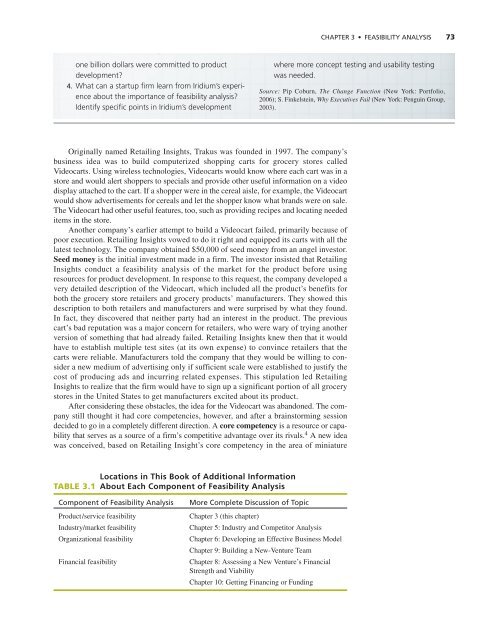feasibility analysis feasibility analysis
feasibility analysis feasibility analysis
feasibility analysis feasibility analysis
Create successful ePaper yourself
Turn your PDF publications into a flip-book with our unique Google optimized e-Paper software.
CHAPTER 3 • FEASIBILITY ANALYSIS 73<br />
one billion dollars were committed to product<br />
development?<br />
4. What can a startup firm learn from Iridium’s experience<br />
about the importance of <strong>feasibility</strong> <strong>analysis</strong>?<br />
Identify specific points in Iridium’s development<br />
where more concept testing and usability testing<br />
was needed.<br />
Source: Pip Coburn, The Change Function (New York: Portfolio,<br />
2006); S. Finkelstein, Why Executives Fail (New York: Penguin Group,<br />
2003).<br />
Originally named Retailing Insights, Trakus was founded in 1997. The company’s<br />
business idea was to build computerized shopping carts for grocery stores called<br />
Videocarts. Using wireless technologies, Videocarts would know where each cart was in a<br />
store and would alert shoppers to specials and provide other useful information on a video<br />
display attached to the cart. If a shopper were in the cereal aisle, for example, the Videocart<br />
would show advertisements for cereals and let the shopper know what brands were on sale.<br />
The Videocart had other useful features, too, such as providing recipes and locating needed<br />
items in the store.<br />
Another company’s earlier attempt to build a Videocart failed, primarily because of<br />
poor execution. Retailing Insights vowed to do it right and equipped its carts with all the<br />
latest technology. The company obtained $50,000 of seed money from an angel investor.<br />
Seed money is the initial investment made in a firm. The investor insisted that Retailing<br />
Insights conduct a <strong>feasibility</strong> <strong>analysis</strong> of the market for the product before using<br />
resources for product development. In response to this request, the company developed a<br />
very detailed description of the Videocart, which included all the product’s benefits for<br />
both the grocery store retailers and grocery products’ manufacturers. They showed this<br />
description to both retailers and manufacturers and were surprised by what they found.<br />
In fact, they discovered that neither party had an interest in the product. The previous<br />
cart’s bad reputation was a major concern for retailers, who were wary of trying another<br />
version of something that had already failed. Retailing Insights knew then that it would<br />
have to establish multiple test sites (at its own expense) to convince retailers that the<br />
carts were reliable. Manufacturers told the company that they would be willing to consider<br />
a new medium of advertising only if sufficient scale were established to justify the<br />
cost of producing ads and incurring related expenses. This stipulation led Retailing<br />
Insights to realize that the firm would have to sign up a significant portion of all grocery<br />
stores in the United States to get manufacturers excited about its product.<br />
After considering these obstacles, the idea for the Videocart was abandoned. The company<br />
still thought it had core competencies, however, and after a brainstorming session<br />
decided to go in a completely different direction. A core competency is a resource or capability<br />
that serves as a source of a firm’s competitive advantage over its rivals. 4 A new idea<br />
was conceived, based on Retailing Insight’s core competency in the area of miniature<br />
TABLE 3.1<br />
Locations in This Book of Additional Information<br />
About Each Component of Feasibility Analysis<br />
Component of Feasibility Analysis<br />
Product/service <strong>feasibility</strong><br />
Industry/market <strong>feasibility</strong><br />
Organizational <strong>feasibility</strong><br />
Financial <strong>feasibility</strong><br />
More Complete Discussion of Topic<br />
Chapter 3 (this chapter)<br />
Chapter 5: Industry and Competitor Analysis<br />
Chapter 6: Developing an Effective Business Model<br />
Chapter 9: Building a New-Venture Team<br />
Chapter 8: Assessing a New Venture’s Financial<br />
Strength and Viability<br />
Chapter 10: Getting Financing or Funding

















